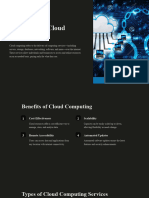0% found this document useful (0 votes)
20 views1 pageCloud Computing
Cloud computing delivers computing services over the internet, enabling users to access and manage data without physical hardware. Key benefits include scalability, cost-efficiency, accessibility, flexibility, and robust security. It encompasses various models like IaaS, PaaS, and SaaS, with applications in data storage, web hosting, collaboration, big data analytics, and software development.
Uploaded by
abdullahiibrahimkhalifa20Copyright
© © All Rights Reserved
We take content rights seriously. If you suspect this is your content, claim it here.
Available Formats
Download as PDF, TXT or read online on Scribd
0% found this document useful (0 votes)
20 views1 pageCloud Computing
Cloud computing delivers computing services over the internet, enabling users to access and manage data without physical hardware. Key benefits include scalability, cost-efficiency, accessibility, flexibility, and robust security. It encompasses various models like IaaS, PaaS, and SaaS, with applications in data storage, web hosting, collaboration, big data analytics, and software development.
Uploaded by
abdullahiibrahimkhalifa20Copyright
© © All Rights Reserved
We take content rights seriously. If you suspect this is your content, claim it here.
Available Formats
Download as PDF, TXT or read online on Scribd
/ 1





















































